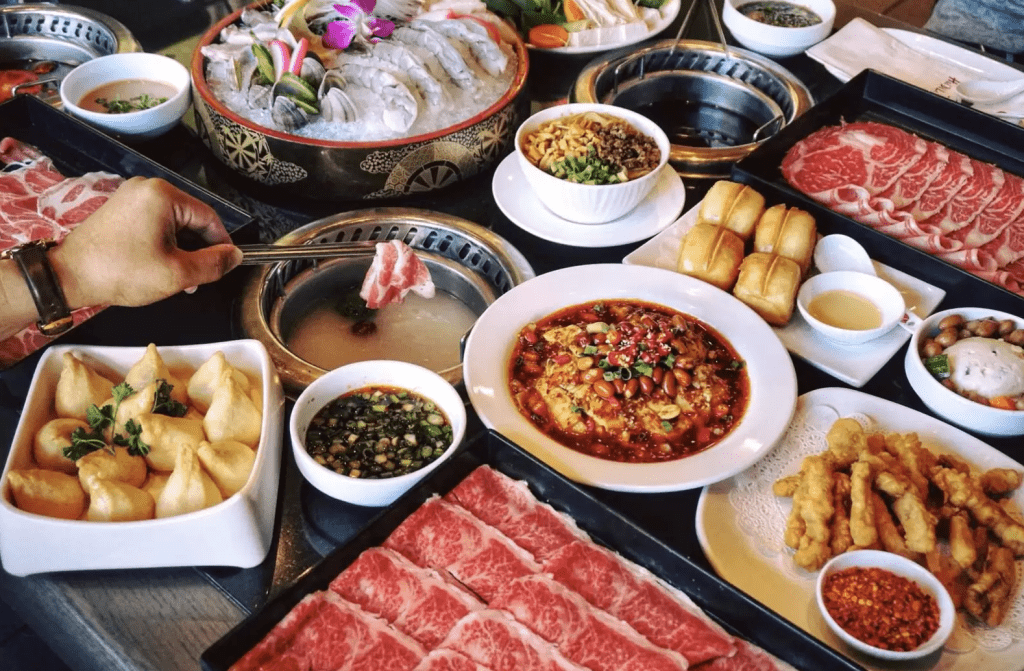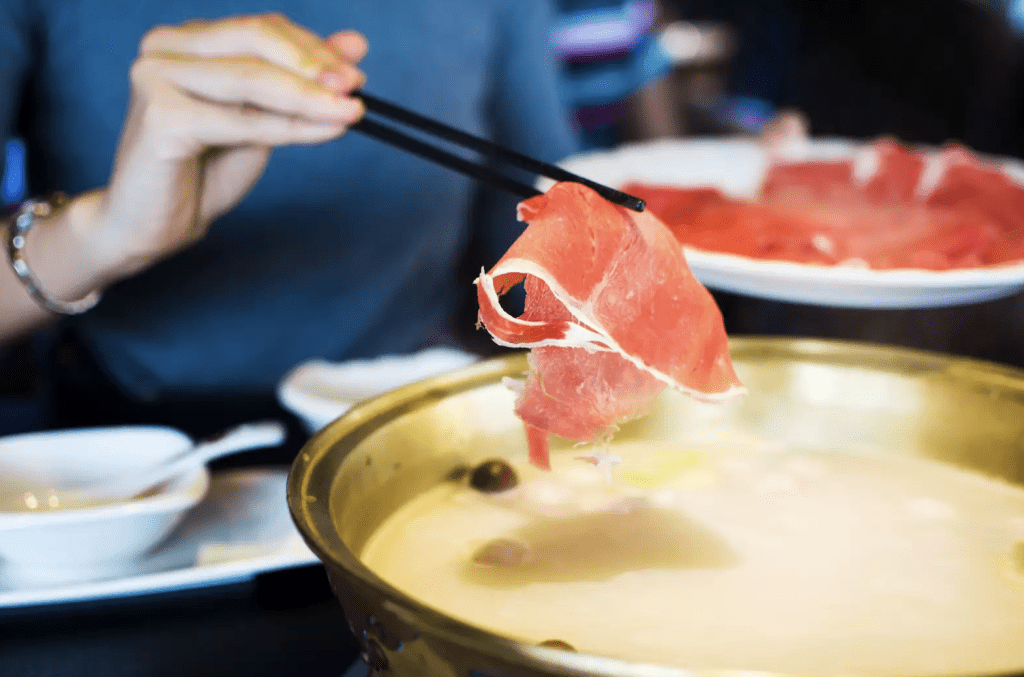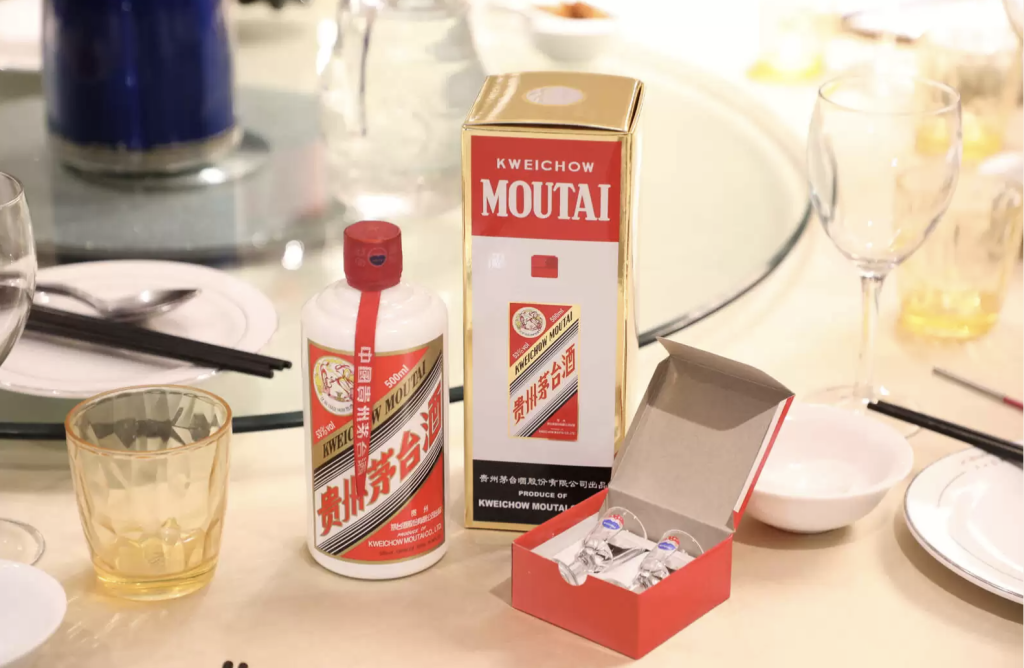With broth gurgling at your table, hot pot is more than just a dish – it’s an experience.

La cucina regionale cinese – dagli spaghetti di Xi’an agli gnocchi di Shanghai – ha una storia ricca e lunga. Ma c’è sempre altro da esplorare. Quello che seguì fu un seguito di culto: hot pot, o huǒ guō (hot pot). Che tu stia andando in un negozio di mamme o in una grande catena, ecco tutto ciò che devi sapere per padroneggiare l’esperienza culinaria pubblica con hot pot.
So what is hot pot?
Hotpot is more of an experience than a dish and embraces the spirit of communal dining that many Western restaurants have only recently begun to adopt. Think of it as an adaptation of the soup-stone fairy tale: you and a group of friends cook a variety of ingredients-thinly sliced meat, mushrooms, shrimp, lettuce, fresh noodles, and more-on an induction stove or electric stove of simmering, seasoned broth. Once cooked to your liking, you can dip it in your favorite sauce and eat it. Rinse and repeat until very full.
Where did the hot pot come from?
There are many types of hot pot in China, but there are distinctly different regional styles. The original, introduced to East Asia by the Mongol Empire thousands of years ago, is a simple broth served with horse and lamb. (Fictional stories describe it as a dish Mongolian soldiers ate while wearing helmets during their travels.) As their cultural influence spread, the hot pot also took a myriad of forms in northern China, South Korea, Japan, and Vietnam.

What does the hot pot include?
A fondue has three basic components: broth, sauces, and sauces.
Stock:
A hot pot restaurant in the United States usually offers a variety of broths to choose from, although sometimes the undecided may opt for a combination with metal dividers in the same pot. The most popular style is a basic cloudy broth made with chicken, ginger, goji berries and other spices. My favorite is the bold and spicy Chongqing variant, filled with Sichuan peppercorns, red peppers, pickled mustard and just about anything else you’ll find on a Sichuan chef’s spice rack. You can choose from delicious mushroom soup, sweet and sour tomatoes, or even seafood soup with coconut in some places.
Immersion:
As for the hot pot ingredients themselves, restaurants usually offer a good mix of thin sliced meats-from pork belly to lamb shoulder to filet mignon-and meatballs, vegetables, noodles, fish balls, dumplings, and rice cakes to order. Sometimes they offer a well-balanced plate of protein and vegetables. For example, Tang Hotpot in New York City offers a delicious-sounding “Sichuan Adventurer” set that includes such dishes as chicken gizzards, Asian eel, tripe, chrysanthemum leaves, vermicelli, and enoki mushrooms. But this is the fancy stuff. You can’t go wrong by ordering pyramids of semi-frozen shaved short rib, hand-cut noodles and cabbage and calling it a day.
Most places offer a variety of dipping sauces for cooked ingredients, and you may or may not use them. Some may even offer a do-it-yourself station complete with items to mix, including chopped cilantro, oyster sauce, sesame oil and black vinegar, with tips for beginners. For many fondue fans, dipping sauce is a very personal thing, so if you want an extra spoonful of garlic, hang that grotesque flag. Here’s a tip: If you see the chive flower sauce on the menu, order it. It was full of umami and everything was great.

How do you eat?
There are a few things to keep in mind as you and your friends dig deeper. First, cook the ingredients gradually and try to adjust to your eating speed. Keep in mind that the food will be hot when you pull it out, so take your time and be sure to wait for the soup to boil again between batches. This last point is crucial. You don’t want to just plunge the frozen chicken into the hot broth: make it hot again because you want everything to be cooked. No chef guarantees quality.
Different foods have different cooking times. For example, mushrooms may take 5 to 8 minutes, while if boiled for more than 10 seconds, thin slices will blanch and become tough. A good rule of thumb is to let firm, hard vegetables soften in the pan while you dip them into smaller, quicker ingredients. If you are unsure of your cooking skills, ask an experienced friend to take the lead!
Definitely use a hand-held basket or designated long chopsticks to retrieve food so that the same utensils are not used for eating and cooking.
From time to time, your server may bring a can of broth and use it to fill your pot. If that happens, don’t panic! They simply balance the flavors and make sure you are not just snorting pure chili oil with your noodles.
What rules should I remember?
Hotpot is largely a communal social meal, so respect the commons. Sharing is the name of the game: send meatballs to your friends, no shrimp paste, no double dip, be sure to pour white wine all over the table. If you want to be truly Asian, a fierce battle over who will pay the check is a must.
Is this expensive?
Since hot pot is a group activity, it is a good deal. Some places will offer a free, refillable basic broth and charge only what you put in or spice upgrades, which would be quite reasonable: about $18 per person if you plan to fill up. Even places that charge for soup may charge only about $10-$15 for the broth you share.
Of course, there are also high-end hot pot restaurants that will charge extra. Szechuan-imported restaurants like Haidilao, known for their excellent service, offer all organic homemade ingredients and fresh ramen, so expect to pay $40-50 per person. We are likely to see more of these as more restaurants catering to wealthy Chinese newcomers open in the United States.
Can hot pot be vegetarian?
Sometimes. More and more hot pot restaurants are serving mushroom or tomato soup, and of course, you’ll have plenty of tofu and vegetables to choose from. Usually, you can also order noodles and extra mushrooms.
